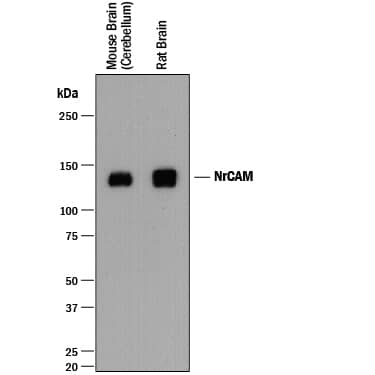Mouse/Rat NrCAM Antibody
R&D Systems, part of Bio-Techne | Catalog # AF8538

Key Product Details
Species Reactivity
Validated:
Mouse, Rat
Cited:
Mouse
Applications
Validated:
Western Blot
Cited:
Immunoprecipitation
Label
Unconjugated
Antibody Source
Polyclonal Rabbit IgG
Product Specifications
Immunogen
Mouse myeloma cell line NS0-derived recombinant mouse NrCAM
Leu30-Pro630
Accession # Q810U4
Leu30-Pro630
Accession # Q810U4
Specificity
Detects mouse and rat NrCAM in direct ELISAs and Western blots. In direct ELISAs, less than 25% cross-reactivity with recombinant human NrCAM is observed.
Clonality
Polyclonal
Host
Rabbit
Isotype
IgG
Scientific Data Images for Mouse/Rat NrCAM Antibody
Detection of Mouse and Rat NrCAM by Western Blot.
Western blot shows lysates of mouse brain (cerebellum) tissue and rat brain tissue. PVDF membrane was probed with 1:1000 dilution of Rabbit Anti-Mouse/Rat NrCAM Antigen Affinity-purified Polyclonal Antibody (Catalog # AF8538) followed by HRP-conjugated Anti-Rabbit IgG Secondary Antibody (Catalog # HAF008). A specific band was detected for NrCAM at approximately 104-145 kDa (as indicated). This experiment was conducted under reducing conditions and using Immunoblot Buffer Group 1.Applications for Mouse/Rat NrCAM Antibody
Application
Recommended Usage
Western Blot
1:1000 dilution
Sample: Mouse brain (cerebellum) tissue and rat brain tissue
Sample: Mouse brain (cerebellum) tissue and rat brain tissue
Formulation, Preparation, and Storage
Purification
Antigen Affinity-purified
Formulation
Supplied as a solution in PBS containing BSA, Glycerol and Sodium Azide.
Shipping
The product is shipped with polar packs. Upon receipt, store it immediately at the temperature recommended below.
Stability & Storage
- 12 months from date of receipt, -20 °C as supplied.
- 1 month, 2 to 8 °C under sterile conditions after opening.
- 6 months, -20 °C under sterile conditions after opening.
Background: NrCAM
References
Hortsch, M. (2000) Mol. Cell. Neurosci.
15:1.
Stoeckli, E.T. and L.T. Landmesser
(1995) Neruon 14:1165.
Mauro, V.P. et al. (1992) 119:191.
Fustig, M. et al. (1999) Dev. Bio.
209:340.
Sakurai, T. et al. (2001) J. Cell Bio.
154:1259.
Custer, A.W. et al. (2003) J.
Neuroscience 23:10032.
Long Name
Neuronal Cell Adhesion Molecule
Alternate Names
Bravo
Gene Symbol
NRCAM
UniProt
Additional NrCAM Products
Product Documents for Mouse/Rat NrCAM Antibody
Product Specific Notices for Mouse/Rat NrCAM Antibody
* Contains <0.1% Sodium Azide, which is not hazardous at this concentration according to GHS classifications. Refer to SDS for additional information and handling instructions.
For research use only
